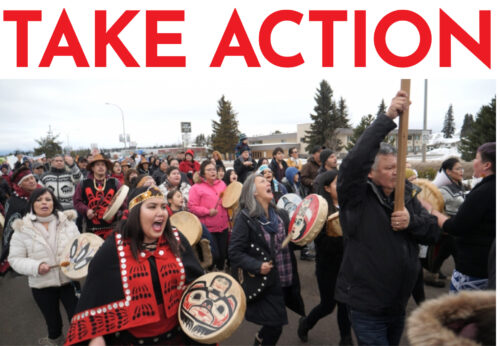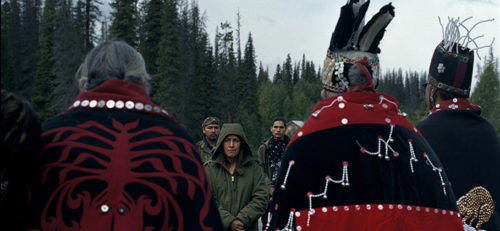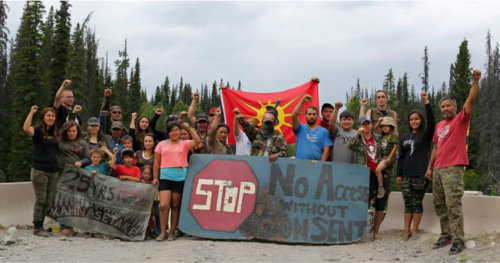|
|
|
|
Wet’suwet’en Supporter Toolkit 2020 |
Relatives,
We wanted to make sure you saw this toolkit our relatives at Unist’ot’en Camp complied
to support the Wt'suwet'en.
Below you can learn more and ways to support them.
Click on the image below to view this information on the Unist’ot’en Camp website.

We stand as witnesses to this historic moment when the federal and provincial governments, RCMP, and Coastal GasLink/TC Energy (formerly TransCanada) are openly violating Wet’suwet’en, Canadian, and international law.
Coastal GasLink/TC Energy is pushing through a 670-kilometer fracked gas pipeline that would carry fracked gas from Dawson Creek, B.C. to the coastal town of Kitimat, where LNG Canada’s processing plant would be located. LNG Canada is the single largest private investment in Canadian history.
Each clan within the Wet’suwet’en Nation has full jurisdiction under their law to control access to their territory. Under ‘Anuc niwh’it’en (Wet’suwet’en law) all five clans of the Wet’suwet’en have unanimously opposed all pipeline proposals and have not provided free, prior, and informed consent to Coastal Gaslink/ TransCanada to do work on Wet’suwet’en lands.
How can you, as a supporter, show your solidarity with the Wet’suwet’en and Unist’ot’en battle against industry giants? What can you do to stem the tide of colonization and corporate greed usurping Indigenous rights?

Come to the Land | Fundraise | Educate | Build Solidarity | Pressure the Government | Donate
COME TO THE LAND

FUNDRAISE

EDUCATE
- Host a film screening of the new documentary, Invasion.
- Write an opinion piece for your local paper, zine, or other publication. Keep the name of the Unist’ot’en in the press, and bypass the media blackout.
- Sign up for the Unist’ot’en Camp Newsletter.
- Share posts on social media, talk to your community, keep eyes on the Unist’ot’en and Wet’suwet’en!

BUILD SOLIDARITY

PRESSURE THE GOVERNMENT

DONATE

Indigenous and Wet’suwet’en Law | Canadian and International Law | History of Unist’ot’en Healing Centre | Allyship and Solidarity | LNG and Fracking | Contacts | Media
INDIGENOUS AND WET’SUWET’EN LAW
Hereditary Law
The Wet’suwet’en Hereditary Chiefs have maintained their use and occupancy of their lands and hereditary governance system, are the Title Holders of their territories, and maintain the authority and jurisdiction to make decisions on their unceded lands. The 22,000 square km of Wet’suwet’en Territory is divided into five clans and thirteen house groups. Each clan within the Wet’suwet’en Nation has full jurisdiction under their law to control access to their territory.
The Wet’suwet’en fought for many years in the Delgamuukw-Gisday’wa court case to have their sovereignty recognized and affirmed by Canadian law. In 1997, the Supreme Court of Canada ruled that the Wet’suwet’en people, as represented by their hereditary leaders, had not given up rights and title to their 22,000km2 territory.
Knowing that further litigation would be prohibitively expensive to Indigenous plaintiffs (and that pipeline construction could be completed before any significant legal issues could be further resolved) TC Energy and the provincial and federal governments are openly violating this landmark ruling. The economic burden and emotional toll this has taken on Freda Huson and her family has been tremendous. They have had to retain two legal teams to deal with daily violations of Indigenous rights and to prepare a response for the injunction.
The Wet’suwet’en and Gitxsan nations have already proven in the Supreme Court of Canada that their Aboriginal rights and title has not been extinguished. Hereditary leaders from across B.C. support the Unist’ot’en. It is deeply unjust to force the Wet’suwet’en to prove their right to live on their own territories (again) in a court system built to dispossess Indigenous people. If the injunction continues to be upheld by the courts, it will be in defiance of both Wet’suwet’en law and Canadian legal precedents.
Update 12/31/19: Wet’suwet’en Hereditary Chiefs Reject the BC Supreme Court Decision to Criminalize Wet’suwet’en Law

Indigenous and Wet’suwet’en Law Articles:

CANADIAN AND INTERNATIONAL LAW, RCMP, CGL, AND THE INJUNCTION
Articles relating to the Injunction and the Invasion in January 2019

CANADIAN LAW, ABORIGINAL TITLE, CGL, and INDUSTRY

HISTORY OF UNIST’OT’EN CAMP AND THE HEALING CENTRE
- The background of the campaign to save the Yintah.
- A timeline of events from the beginning of reoccupation until January 2019.
- A piece by the Stimulator, from Action Camp, 2013.
- RESIST: A 2013 documentary about the camp.
- A tiny Batman and the youngest Unist’ot’en take us through an example of Protocol at the bridge.
- Unist’ot’en Matriarchs jarring salmon under the first threat of raid, in 2015.
- Asking TransCanada to leave, 2015.
- 2015 piece from Al Jazeera: Holding Their Ground Against Oil & Gas Pipelines.
- A supporter made video about visiting Unist’ot’en in the winter, 2016/2017.
- Talking about building the cabins and healing on the land, 2017.
- A 5 part video series on resistance in Indigenous territory, and the cultural mission of the centre, 2017.
- What the Healing Centre does for the people, 2018.
- CGL forces the gate at Git’umden, and raid expected at camp, January 2019.
- Everything from January 10th 2019 until June 2019.
- CGL bulldozes a trapline and defies cease work order after artifacts found.
- The Unist’ot’en go to court to fight the injunction, June 2019.
- Youth Art Camp is held at the Healing Centre.
- TC Energy and CGL bulldoze the Kweese Trail, August 2019. And in text.
- The short version of the documentary, Invasion, is released, detailing the last year, including Freda Huson’s visit to the United Nations
- Supporter arrested while within Unist’ot’en territory, and abiding by injunction.

ALLYSHIP AND SOLIDARITY

CONTACTS AND SOCIAL MEDIA

MEDIA FOR DISTRIBUTION

LNG, Fracking and Coastal Gaslink
What is LNG and how is it produced? How does Coastal Gaslink relate to fracking and why do the Wet’suwet’en say no to an LNG pipeline on their territories?
This backgrounder provides a summary of recent research and offers lots of additional resources for you to brush up on everything you need to know about LNG in British Columbia.
Download as PDF| Access as Google Doc
Click here to access the previous Supporter Toolkit, from January 2019
___
###
Established in 1990, The Indigenous Environmental Network is an international environmental justice nonprofit that works with tribal grassroots organizations to build the capacity of Indigenous communities. IEN’s activities include empowering Indigenous communities and tribal governments to develop mechanisms to protect our sacred sites, land, water, air, natural resources, the health of both our people and all living things, and to build economically sustainable communities.
|
|
|
|
|
|
|
|